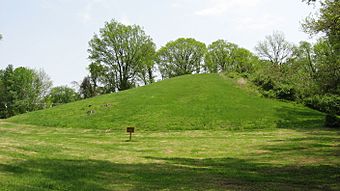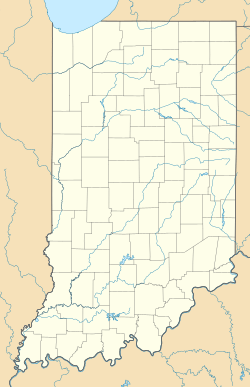Pyramid Mound facts for kids
Quick facts for kids |
|
|
Pyramid Mound (12k14)
|
|

View from the north
|
|
| Location | Southern side of Wabash Avenue, southeast of central Vincennes |
|---|---|
| Nearest city | Vincennes, Indiana |
| Area | 5 acres (2.0 ha) |
| NRHP reference No. | 75000023 |
| Added to NRHP | May 12, 1975 |
Pyramid Mound, also known as 12k14, is an important archaeological site in Vincennes, Indiana. This large hill looks like a pyramid and is a special landmark for people living in the city today. It also holds clues about ancient people who lived there long ago.
What is Pyramid Mound?
Pyramid Mound is a big hill located on the edge of Vincennes. It's made of a type of soil called loess. Even though it looks like a pyramid, it's actually a natural hill. For many years, people thought it was built by ancient cultures.
Exploring the Past: Archaeological Discoveries
In the early 1960s, experts from the Illinois State Museum studied the area around Vincennes. They found that a group of people called the Vincennes culture once lived there. These people were part of the larger Mississippian culture.
In the late 1800s, some people thought Pyramid Mound was connected to other large earthworks built by the Hopewell tradition in Ohio. They even thought it might be linked to the big city of Cahokia near St. Louis, Missouri. Some believed it was a religious site, like the pyramids built by the Aztecs in Mexico. These early ideas often grouped different ancient cultures together, even if they were very different.
Later, in the 1970s and 1990s, professional archaeologists studied the mound more closely. They found that Pyramid Mound and other similar hills nearby were actually natural loess hills. Ancient Native Americans from the Woodland period used these natural hills as cemeteries.
Scientists came to this conclusion for several reasons. These hills are all about the same size and made of the same soil. They are also found on the eastern side of the Wabash River valley. Plus, their shapes seem to be formed by the prevailing winds. So, even though they look like artificial burial mounds and are called "mounds," they are natural landforms.
Protecting This Special Place
Even though Pyramid Mound is a natural hill, it is still a very important archaeological site. Because of its historical value, it was added to the National Register of Historic Places in 1975. Today, the "mound" is part of a park. The Knox County Parks and Recreation Department takes care of it.



